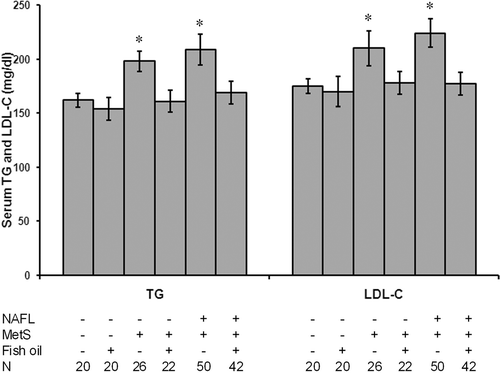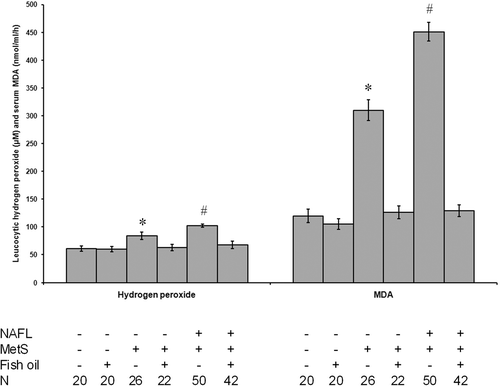Figures & data
Figure 1. Fish oil significantly reduced serum level of triglycerides (TG) and LDL-C in patients with NAFLD and MetS. All patients without fish oil treatment showed a significant increase in serum TG and LDL-C levels as compared with controls. Patients with both NAFLD and MetS showed significant increase in TG and LDL-C as compared with patients MetS alone. Treatment of the patients with fish oil blocked the increase in serum level of both TG and LDL-C. *Significant difference as compared with the control group at p < 0.05. N, number of subjects in the group.

Figure 2. Fish oil reduced oxidative stress in patients with NAFLD and MetS. All patients without fish oil supplementation exhibited a significant increase in H2O2 and MDA levels as compared with the controls. Furthermore, patients with both NAFLD and MetS showed a significant increase in H2O2 and MDA levels as compared with the MetS group. Treatment with fish oil blocked these effects in patients and did not affect the levels in controls. *Significant difference as compared with the control group at p < 0.05. #Significant difference as compared with the rest of the groups at p < 0.05. N, number of subjects in the group.

Figure 3. Fish oil blocked inflammatory cytokines release in patients with NAFLD and MetS. As shown in the figure, all patients without fish oil showed increased levels of proinflammatory cytokines as they showed a significant increase in TNF-α and IL-6 levels as compared with the controls. Treatment with fish oil blocked these effects in patients and did not affect the levels in controls. *Significant difference as compared with the control group at p < 0.05. #Significant difference as compared with the rest of the groups at p < 0.05. N, number of subjects in the group.
